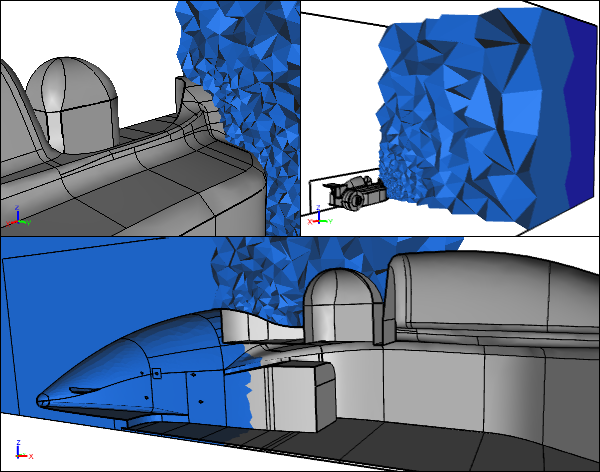
7 Ideas For Your Year Ahead in CFD
2015 is here, but before we leave last year in the dust let's take a moment to review the 2014 blog posts that can make this year your best yet in Computational Fluid Dynamics (CFD).
 External CFD Flow VolumeSubstance (air) modeled outside the car. Half model due to symmetry.
External CFD Flow VolumeSubstance (air) modeled outside the car. Half model due to symmetry.
CFD Flow Volumes and Solid Models
Solid modeling is the dominant form of virtual object representation underpinning nearly all 3D Computer-Aided Design (CAD) systems. The strength of a solid model is that it defines a water tight (manifold) unambiguous object which implicitly delineates between the inside and the outside of an object simply by the alignment of the boundaries (B-rep or BREP) that define it. This makes solid modeling an ideal basis for virtual analysis techniques, e.g., stress analysis and CFD. Also solid modeling provides a relatively straightforward path to manufacture through CNC machines and, more recently, 3D printing. Read more >>
5 Tips for CFD Flow Volume Creation
Configuring a flow volume for CFD is often the most difficult task during the simulation process. Follow these 5 tips to make your CFD flow volume creation less painful. Read more >>
6 Things to Consider Before Switching Turbulence Model
Turbulence modeling for the Reynolds Averaged Navier-Stokes (RANS) equations - the basis of most industrial CFD software - is a complex field. Trying to strike a balance between accuracy and computational efficiency has given rise to a relatively large number of different turbulence models. I am not aware of a definitive list to match turbulence models to applications - if you are, please share! With this in mind I'll share 6 suggestions before you consider switching the default turbulence model in your CFD software. Read more >>
Speed Up CFD with Symmetry and Cyclic Conditions
Symmetry (or planar symmetry) and cyclic (or rotational symmetry) boundary conditions for CFD can often save you 50% or more in simulation turnaround time. Alternatively you can use the freed up memory to run more accurate simulations with more mesh cells clustered in areas of interest. Clearly these simulations are worth considering if your model satisfies the symmetry or cyclic criteria. Read more >>
Small Feature Removal for CFD
In preparing geometry for a CFD simulation you will sometimes find small geometry features (edges and faces) that are irrelevant for your simulation. To resolve a small irrelevant feature would require a large number of small mesh cells that would be a waste of precious computing resources. Keep reading to find out how to detect and remove such features. Read more >>
How to Fix Small Acute Angles for CFD
Small acute angles in your geometry, such as those found where a tangential surface meets a cylindrical surface, can lead to poor results from your CFD simulation. Keep reading to learn how to identify and remedy acute angles. Read more >>
Sliver Treatment Strategies for CFD
Extremely thin, high-aspect-ratio geometry faces (also known as slivers) can cause problems for meshing and adversely affect CFD simulation stability. Learn some strategies to identify and deal with slivers to maximize your CFD productivity. Read more >>
- Richard Smith's blog
- Login to post comments
Select Language
Recent blog posts
- CFD Simulates Distant Past
- Background on the Caedium v6.0 Release
- Long-Necked Dinosaurs Succumb To CFD
- CFD Provides Insight Into Mystery Fossils
- Wind Turbine Design According to Insects
- Runners Discover Drafting
- Wind Tunnel and CFD Reveal Best Cycling Tuck
- Active Aerodynamics on the Lamborghini Huracán Performante
- Fluidic Logic
- Stonehenge Vortex Revealed as April Fools' Day Distortion Field

